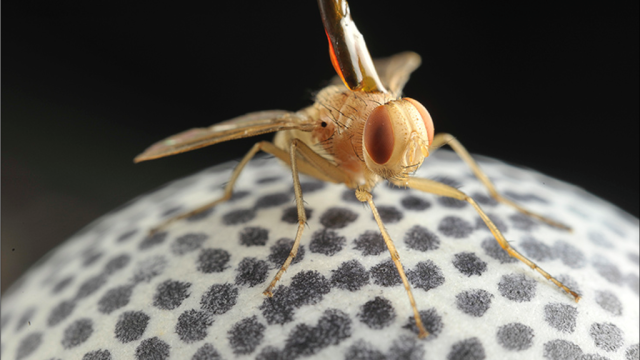You’re a tiny parasitic fly, minding your business, stuck with wax to a tether and standing on a spherical treadmill. Why? You don’t quite remember, but it’s fine. This is what you do now.
Image: Lee et al
Suddenly, a cricket chirps, and another sound plays somewhere near it. Ah! I must approach that cricket, you think. I must raise my larvae on top of it. Because that is also what I do. So you run, run towards where you think the sound of the cricket is coming from. But in the distance, a pair of scientists gasp in surprise. Why isn’t that fly running towards the cricket sound?
Scientists have been using the Ormia ochracea fly in order to develop hearing aids that don’t just amplify sound; they can actually tell the listener where the sound came from. That’s because the tiny fly can tell the direction a sound came from, despite the fact that it essentially hears the sounds at exactly the same time in both ears. But a pair of researchers came across a problem with the insect’s ears that might complicate the goal of turning them into new ears for humans.
“If we’re in a noisy situation and want to perceive the speech of a single person in front of us and they’re beside a source [of noise], it will be harder to hear the speech from the one person,” study author Norman Lee, now assistant professor of biology at St Olaf College in Minnesota, told Gizmodo. “But if we spatially separate the person from the noise, then it becomes easier for us to perceive that signal of interest.”
You’d think that flies, like humans, would better locate the source of a sound if it was more isolated from some masking background noise. “That’s not what we found,” said Lee. “That was part of the interesting result.”
The experimenters first played a cricket sound without any background noise, and the fly seemed to walk towards it on the treadmill. When the researchers introduced a masking noise to the right of the cricket, the fly’s path on the treadmill veered slightly to the left, and vice versa. When the masking noise was far to the right of the cricket’s, the fly’s path veered even further to the left — implying that the fly was even worse at determining the cricket sound’s location with further separation of the two.
You might think the fly was just afraid of the unfamiliar background sound, but when the researchers played the background noise without the cricket, the fly moved a little bit and then stood still, according to the study that will be published in the journal eLife.
Plenty of things might explain what was going on here, mainly involving the fly’s biology and how it actually hears. But the important thing is that if you’re using these flies to make better hearing aids, the results present a potential issue. Wearers of the fly-inspired aids might not be able to distinguish where sounds came from in the presence of multiple sources from different directions, either.
The study’s reviewers pointed out something important — the study only tests separations between a source and a masking noise of around six degrees or higher, and doesn’t test the two coming from smaller separations or the same place. That means the researchers can’t conclude whether or not the fly can tell the difference between sounds coming from smaller angles of separation.
Lee was quick to point out the study’s other limitations, too. The fly is tethered to a trackball, so “nothing about the sound is changing while they’re walking”. This isn’t anything like what happens in the wild, where there are a lot of sounds potentially masking the cricket’s, and obviously the fly can still find the cricket because it hasn’t gone extinct.
So, what’s next for the hearing aid researchers? Lee pointed out that they may already be working on solutions and processing algorithms for this problem. I reached out to the researchers behind past fly-inspired hearing aid research to see whether they had any comment, but had not heard back at time of writing.
If you do find yourself stuck to a trackball running aimlessly towards a cricket while disappointing some higher power, though, worry not. You tried your best.
[eLife]
